 USA – Armoured Cruiser
USA – Armoured CruiserWW1 and prewar USN Cruisers
Atlanta class | USS Chicago | USS Newark | USS Charleston | USS Baltimore | USS Olympia | USS Philadelphia | USS San Francisco | Cincinatti class | Montgomery class | Columbia class | New Orleans class | Denver class | Chester class | Omaha classUSS New York | USS Brooklyn | Pennsylvania class | Saint Louis class | Tennessee class
The first USN Armoured Cruiser: The USS New York, later Saratoga, is certainly not as well-known as the aircraft carrier that fought in ww2 “lady sara”, but she will remains the first of a kind, the first armoured cruiser built in the USA (ACR2). She was born USS New York and “ACR1” was given to USS Maine, reclassified later as a small battleship. Four a young navy forging out a new fleet of modern ships equal to European standards, USS New York was every bit a success. She served also for quite long, ending her career in the Philippines, scuttled to avoid Japanese capture in December 1941, after being known as the USS Rochester and partially rebuilt, in the interwar.
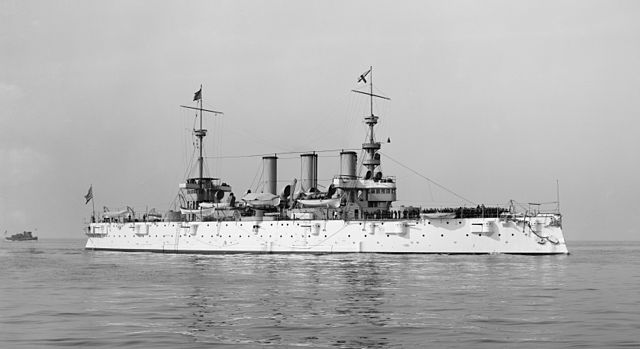
USS New York before the 1898 war.
First life: USS new York
Development
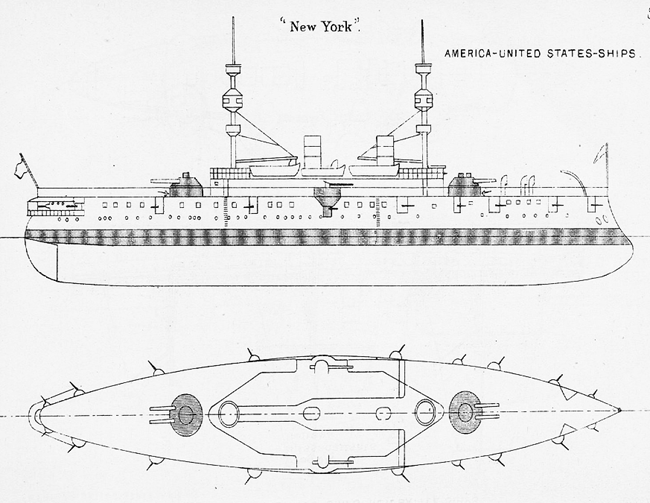
The very first armoured cruiser of the USN was, for most authors, USS Maine. Ordered in 1886 as a complement to USS Texas she was described afterwards both as a second rate battleship than as armoured cruiser. The truth is that she was mostly leaning towards the first, given her proportions (large beam, short lenght) limited speed, and peculiar arrangement for her main armament, with two twin 10 in (254 mm) guns in echelon. She was supposed in addition to match the earlier Brazilian Riachuelo class which were also comparatively, second class battleships.
But it was soon apparent she would be perform poorly as a “cruiser”, despite being designated so (ACR-1) and looking at European designs, it seems more judicious to have a faster, narrower ship with two twin guns in the axis and a quick firing armament. The 10-in guns were placed that way on Maine to ensure better balanced but similar armament fore and aft was believed to cause excessive rocking, and the naval staff agreed to a compromise, choosing newly developed 8-inches/35 guns that fired twice faster than the 10-in of the Maine, while better suited for the new arrangement fore and aft.
While USS Maine was laid down on 17 October 1888 at New York Naval yard, the new cruiser (ACR-2) was authorized by the Congress under the act of 7 September the same year. She was very different from Maine, apart some similarities such as her flush deck hull, she was a completely different animal.
Construction
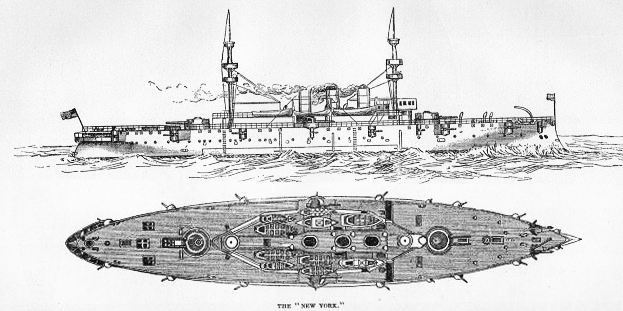
USS New York was built at Cramp in her namesake city of New York, and had handsome lines with a potent armament. Her blueprints were finalized in late 1889, a radical departure over USS Maine as she was sleeker, faster, with less armour, concentrated on the most vital parts, as should be in a proper cruiser. Armament was also “lighter” with these 8-inches guns, completed by a generous secondary armament of twelve 4-in (102 mm)/40 caliber rapid fire guns versus half that or slower-firing six single 6 in (152 mm) guns on Maine. She was a good substitute to a battleship, as many in the general staff wanted these new armoured cruiser to take part in the battleline if required, or better suited for distant stations. USS New York was laid down on 30.9.1890, launched 2.12.1891 and commissioned on 1.8.1893, in fact two years earlier than Maine (17 September 1895). USS Maine indeed experienced numerous delays, starting with the late delivery of Bethlehem nickel steel plates, plagued by strikes. Main ended much costier than New York, the latter estimated to $2,985,000 (as contract price for the hull and machinery) or $96,773,700 in 2022 $US.
Design

Unofficial plans of the armoured cruiser USS New York (ACR-2), first published in the Transactions of the Society of Naval Architects and Marine Engineers 1893.
General Layout
USS New York was a 8200 tonnes ship, 9,021 tonnes fully loaded, and 117 meters long (384 ft) overall (or 380 ft 6 in or 115.98 m between perpendiculars), for 19.76 wide (384 x 64 feet 10 in, 1/5 ratio) she was wide as well, but less than Maine (324 ft 4 in/57 ft or 98.9 m/17.4 m). She also had a slightly greater draught than Maine at 23 ft 3 in (7.09 m) versus 22 ft 6 in (6.9 m) mean in both cases.
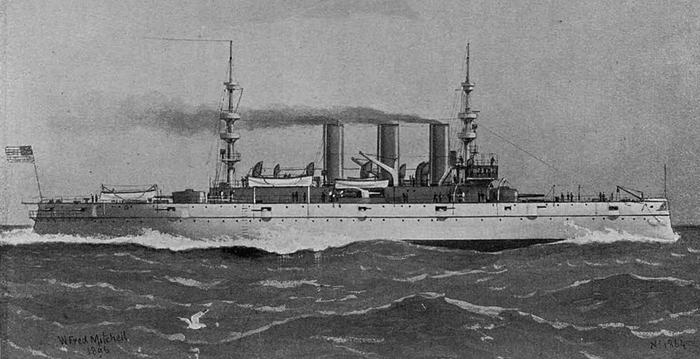
She still looked “compact”, but less than Maine, with a lozenge shaped central structure, with main twin turrets still close to her center, a low bridge, mounted above her forward conning tower, the latter just clearing out the roof of “A” main turret. The latter both had two observation posts for backup fire direction. The bridge affected a “triangular” shape, and there was a double open wing. The central structure sported three tall funnels, and two cranes for a fleet of 12 boats (only two under davits). The prow ended with a pronounced ram and its head was well ornamented in conformity of the 1890s style, she also had two anchors and a service crane to manage them and single capstan close to “A turret”.
The flanks were flat, no tumblehome, and the stern was adorned with an officer’s gallery. USS New York had two symmetrical military masts for and aft, supporting three levels: A searchlight top, a fighting top (with two guns), and a spotting top. Boom cranes were anchords on them to managed the fleet of boats on deck. Ventilation was provided by six main air scoops, six secondary, and four on deck forward, likely to ingest seawater in heavy weather. The location of the two wing guns, a solution that was repeated, but with twin turrets on USS Brooklyn, created blast issues for the structure and boat above when firing either forward or aft. There were also two fixed ladders and two lifting stairs per side. The secrondary and tertiary guns were arranged in casemated sponsons all along the battery deck.
Powerplant
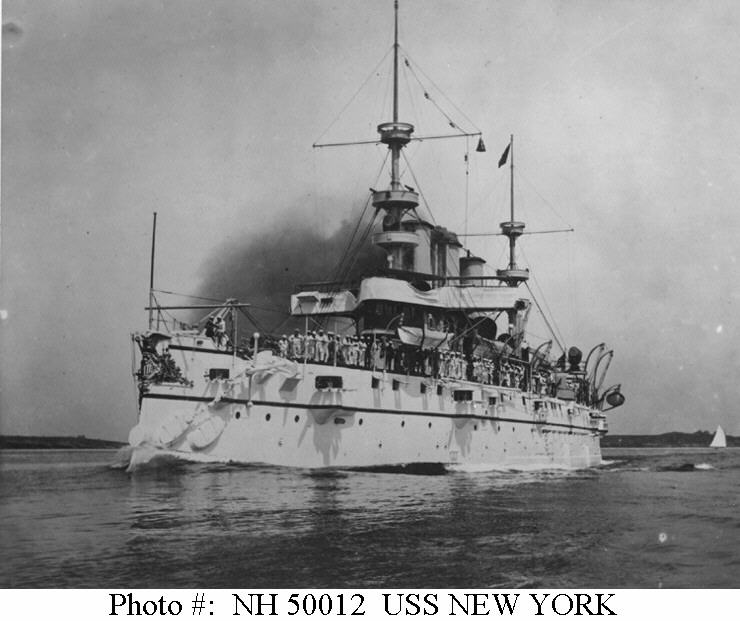
At sea, full speed ahead – Archive From Navsource.
USS New York received two propellers, clutched in tandem on each of the shafts. She had four vertical triple expansion, fed in turn by eight cylindrical boilers rated at 160 psi (1,100 kPa).
This generated a total output of 16,000 ihp for a top speed of 20 knots. She was was intended to be relatively fast at 20 knots (37 km/h; 23 mph), much more than Maine (16.5 knots/30.6 km/h; 19.0 mph) and even achieved 21 knots (39 km/h; 24 mph) on trials.
She carried 750t in normal load and up to 1,290 tonnes max of coal. It is assumed she normally had a 4,000 nautical miles range as 10 knots.
Her cruise was helped by disconnecting her forward engines. She shared this feature with USS Brooklyn, but this proved a liability at the Battle of Santiago de Cuba (both were left behind) as they operated with the forward engines disconnected, and did not have time to reconnect them.
Protection
Protection was good, with the following:
Belt: 4 in (102 mm), 9 ft (2.7 m) tall (4 ft (1.2 m) underwater) over 186 ft (57 m) long amidship.
Armored deck: 6 in (152 mm) on the slopes, 3 in (76 mm) on flat, 2+1⁄2 in (64 mm) ends.
Turrets: 5-1/2 inches (140 mm) with vertical faces or “cheesebox” shaped.
Main Barbettes: 10 in (254 mm). Ammunition hoists 5 in (127 mm)
Wings guns: Open single 8-inch mounts with 2 in (51 mm) partial barbettes
Secondary gun sponsons: 4 in (102 mm).
Conning tower: 7 1⁄2 in (191 mm) walls, rood thickness unknown.
ASW protection: Reconfigured boiler arrangement for tighter compartmentation compared to Maine.
This level of protection was somewhat a bit inferior to the belt of the French Dupuy de Lôme, but New York surpassed HMS Blake both in armament and protection, the British then swapping over protected cruisers instead.
Armament
Her armament comprised six 8-in/35 calibre guns (203 mm) in twin turrets fore and aft and two single mounts in the centre, on port and starboard. Her secondary armament comprised twelve Quick-Firing 4in/40 cal. guns (110 mm) in sponsons, but also a handful of 6-pounder (57 mm (2.2 in)) Driggs-Schroeder to deal with TBs close, plus four others 1-pounder (37 mm (1.5 in)).
You may have never heard of Driggs-Schroeder as a gun maker, but this Driggs-Seabury Ordnance Company funded in 1897 delivered three types of QF guns of the “single shot”, with brass cased ammunition type, to USS Texas, Maine, Olympia, New York, and Brooklyn.
They also designed a 4-inch/40 calibre that was adopted as a defence by several forts and naval bases.
For closer range, USS New York also carried three 14 in (356 mm) Howell torpedo tubes.
8-inch/35-caliber Mark 3 guns
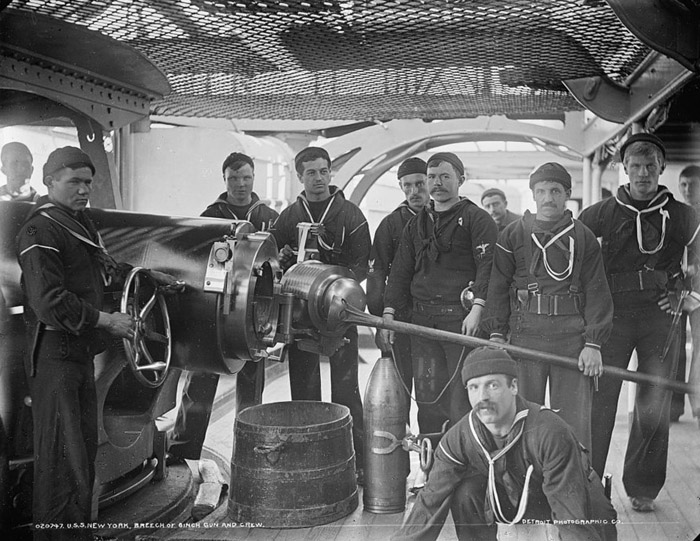
USS New York had six of them, four in tandem turrets for and aft and two single ones under light shields on the wings, with a 140° arc. This gave them a broadside of five, and chase of retreat fire of four. The way the superstructure was shaped helped the fore and aft turrets to fire along a generous arc of fire included to the left, only limited to the proximity of the gun blast to the structure.
Mark 3 specs:
Weight 29,400 lb (13,300 kg) without breech.
Gun mounts: Mark 4 for the two Single center-pivots and Mark 5 for the Twin Turrets
Shell: 260 lb (120 kg) armor-piercing
Muzzle velocity: 2,100 ft/s (640 m/s)
Elevation: -5 to +20°
Rate of fire: 0.5 – 0.8 rounds per minute
Effective firing range: 16,000 yd (14,630 m) at 20.1° elevation
4-inch/40-caliber Mark 3 gun
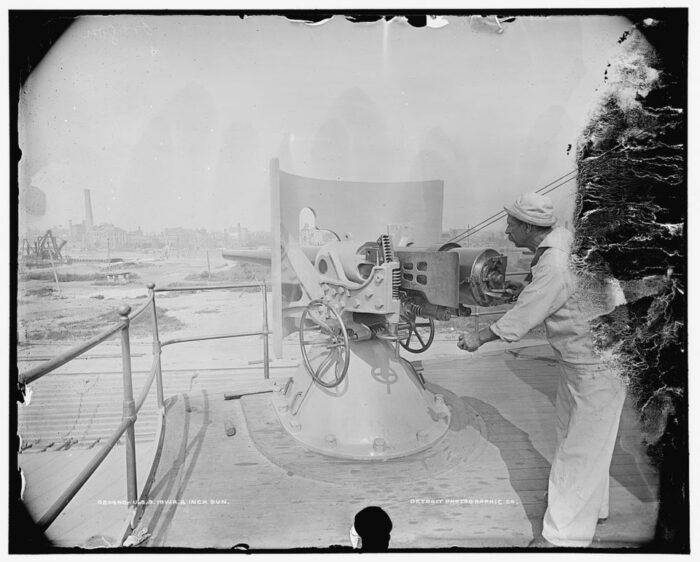
In all, USS New York had twelve 4 in (102 mm)/40 caliber rapid fire (RF) guns, all mounted in the battery deck, under sponsons casemates, six per side. USS New York was the only armoured cruiser to sport them. They were usually seen in early battleships such s USS Iowa, and the Columbia class protected cruisers as well as three gunboats. They were likely equipped with the Mark 3 mod 0, later updated to the Mark IV, V, and VI in her career.
Weight: 3,388 lb (1,537 kg) without breech for 164 in (4.2 m) barrel 160 in (4.1 m) bore (40 calibers).
Shell: 33 lb (15 kg) armor-piercing 4 in (102 mm)
Elevation -15° to +20°, Traverse −150° to +150°
Rate of fire: 8–9 round per minute, muzzle velocity 2,000 ft/s (610 m/s)
Effective firing range: 11,500 yd (10,500 m) at 31.2° elevation.
6-pounder (57 mm (2.2 in))
Eight of them were arranged in the battery deck’s sponsoned casemates, two close to the stem forward, two abaft the bridge, two below the wings main guns, and two at the extreme aft, in side the stern “gallery”. They were 45 caliber Diggs-Scroeder’s Mark I, licenced versions of the French Hotchkiss gun.
In short, these guns had a 25 rounds a minute rate of fire, with a muzzle velocity of 1,818 feet per second (554 m/s) and effective firing range of 4,000 yards (3,700 m).
1-pounder Mark 6
These four guns acted both a defence against TBs but also as saluting guns, adapted from the Maxim-Nordenfelt 37 mm 1-pounder. The had enough elevation also to act as AA guns, and were located by pairs fore and aft of the fighting tops on both masts.
Torpedo Tubes
These three 3 × 14 in (356 mm) tubes were located in a classic arrangement, one above water in the prow, and two below he waterline and main belt firing on the broaside. The torpedo model was probably the Howell. Later replaced by Bliss & Williams models until they were retired.
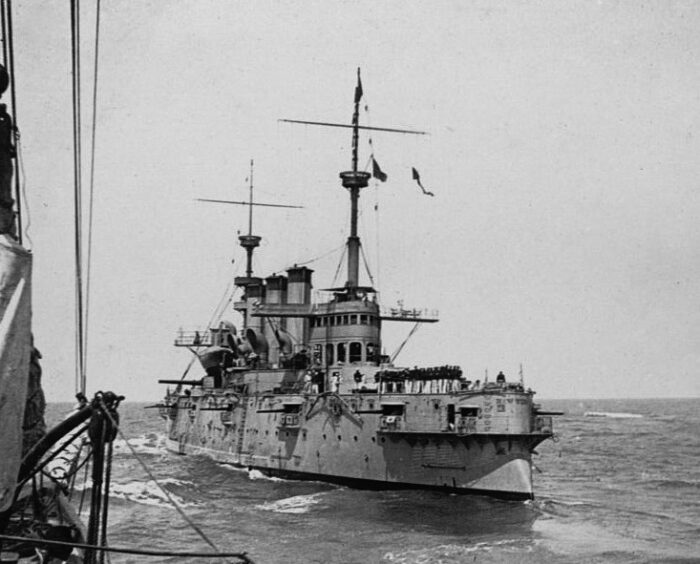
Stern view, 1898, note the “aft bridge”, well developed.
Modifications
1905-1909 Overhaul: Old armament removed. We installed: Two twin 8-inches(203 mm)/45 Mk VI (wings guns removed), ten 5-in(127mm)/50 Mk VI, eight 3-in(76mm)/50 Mk III/V/VI. The new main gun turrets were protected by 165mm Krupp steel and 152-102mm barbettes. Thinner armour but the protection was the same given the new armour process.
On the machinery side, the old boilers were replaced by twelve Babcock & Wilcox with even higher funnels.
1919 refit as USS Saratoga: She lost two 5-in/50 guns and eight 3-in/50 but gained two 3-in(76mm)/52 Mk X AA guns instead.
1927 as USS Rochester: Eight boilers and 2 funnels were removed.

USS Saratoga in WW1, drawing by the author

Conways profile
⚙ specifications as built |
|
| Displacement | 8,150 long tons (8,281 t) standard, 8,900 long tons (9,043 t) full load |
| Dimensions | 384 ft x 64 ft 10 in x 23 ft 3 in (117 x 19.76 x 7.09 m) |
| Propulsion | 2 shafts, 4× VTE, 8 × steam boilers: 16,000 ihp (12,000 kW) as designed |
| Speed | 20 knots (37 km/h; 23 mph) as design |
| Range | 4000 nm at 10 kts |
| Armament | 6× 8 in/35 (2×2, 2×1), 12 × 4 in/40 RF 8× 6-pdr RF, 4× 1-pdr, 3× 14 in TTs |
| Protection | Belt 4 in, Deck 6-3 in, 2+1⁄2 in, Turrets 5+1⁄2, Barbettes 10 in, side barbettes 2 in, sponsons 4 in, CT 7+1⁄2 in |
| Crew | 53 officers, 422 enlisted, 40 Marines |
Career of USS New York
Before the war, she operated with the South Atlantic Squadron, and cruised along Brazil and Nicaragua, before joining East Indies. Transferred to the North Atlantic Squadron before again sailing to the East Indies. Ironically she was called to the rescue to help to extinguish a fire threatening to destroy Port of Spain, Trinidad.
She later joined European Squadron in 1895, and made the opening of the Kiel canal in behalf of the US Navy.
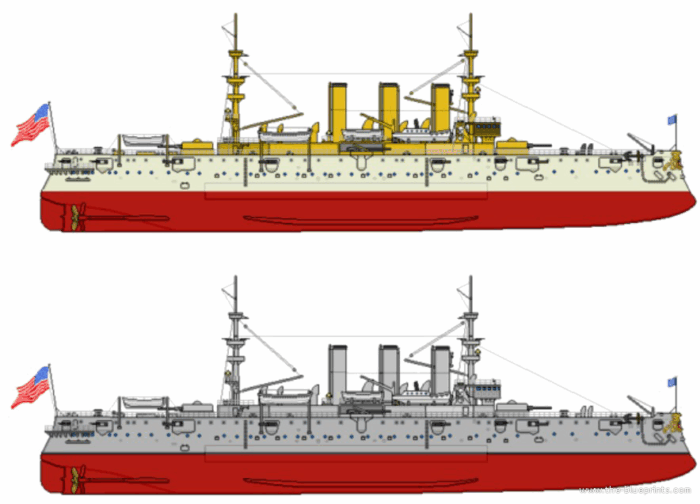
Appearance, as completed, USS New York 1895, USS Saratoga WW1.
The war of 1898
At the start of the war she was transferred to Key West. From there, she sailed to Cuba, shelling the Spanish defences at Matanzas, then joining the squadron at San Juan to hunt down Cervera’s squadron, without much success.
She later shelled Castillo San Felipe del Morro and was promoted flagship of Admiral William T. Sampson’s squadron, bound to Santiago. However, when news arrived of the Spanish squadron spotted, her cruise mode was activated, and the time needed to reconnect all her shafts meant she only participated in the closing phases of the battle.

USS New York, enforcing the 1898 blockade.
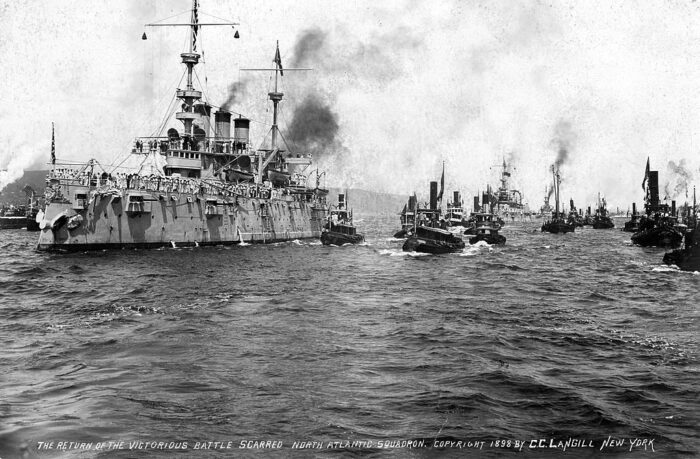
After the war, she cruised with various South American naval militias and was transferred to the Asiatic Fleet in 1901 (flagship). She steamed to Yokohama in July (memorial to the Perry Expedition), sailed to the Philippines, Hong Kong and other Chinese ports, Vladivostok, and then back to San Francisco.
She was transferred to the Pacific Squadron and among others took part in enforcing the President’s neutrality order during the Russo-Japanese War.
The ship was undergoing an extensive refit, from 1905 to 1909. She received a lighter armament of four 8 in (203 mm)/45 calibre Mark 6 guns in brand new Mark 12 turrets which had improved Krupp cemented armor. This was up to 6 1⁄2 in (165 mm) (turrets) and 6 in (152 mm)-4 in (102 mm) (barbettes).
The torpedo tubes were removed and secondary armament changed for ten 5 in (127 mm)/50 calibre Mark 6 guns and eight 3 in (76 mm)/50 calibre guns. On the engine compartment she received twelve Babcock & Wilcox boilers. Funnels were taller to improve draft. After being recommissioned in 1909 she departed for the Mediterranean Armoured Cruiser Squadron, then in 1910, joined again the Asiatic squadron.
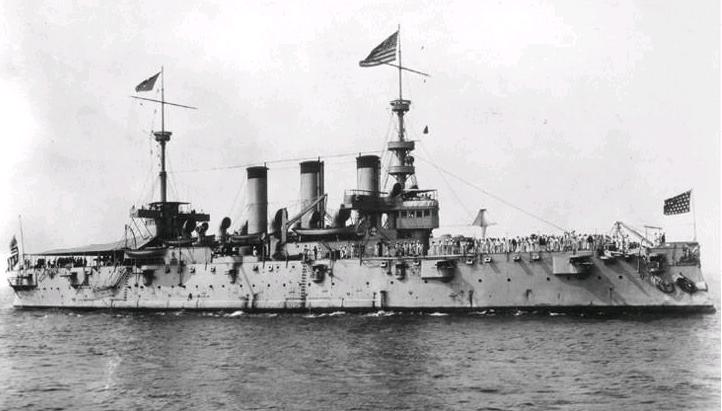
USS New York at the victory celebrations 1898 naval review
As USS Saratoga (1911-1933)
She was renamed on 16 February 1911 to free the name for a new American dreadnought (BB-34). She spent the next five years in the Far East, before joining the Pacific Reserve Fleet. Then WW1 broke out, and she went on patrolling with Pacific Patrol Force from June, 7, 1917, policed the Mexican coast, and later joined the Cruiser Force, Atlantic Fleet. She was also refitted during World War I: Two 5-inch were removed as well as all the 3-inch. Two 3 in (76 mm)/50 anti-aircraft guns were added.
Third life: USS Rochester and final days in WW2
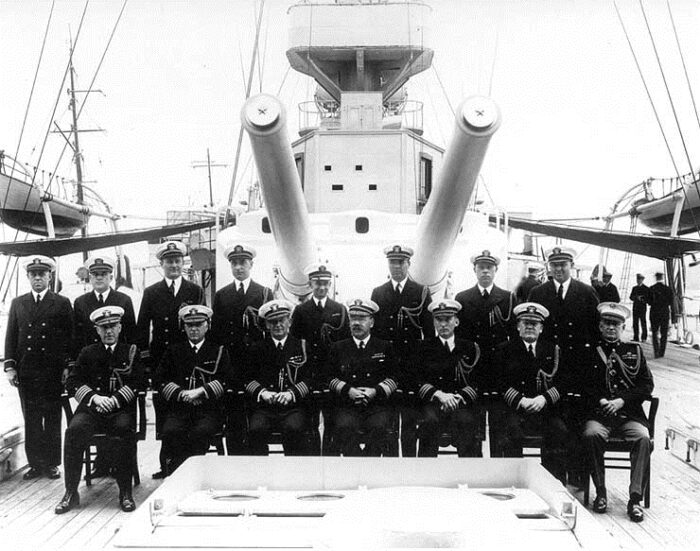
USS Rochester at Shanghai in 1932 with the US Asiatic Fleet staff posing next to “B” turret
On 1st December 1917, she was renamed to free the name for the new battlecruiser. Her last active mission was for escorting a convoy to France, but upon return she went a new career, as a target and defence instruction of armed guard crews in Chesapeake Bay. From March 1918 to the end of armistice, she went on new escort missions, helping to rescue crews of the steamer Atlantian.
After the war she served as a troop transport back home. She was redesignated by the navy hull number CA-2 and went on to serve in South America and the Caribbean. In 1925, she transported General John J. Pershing to solve a diplomatic dispute in Chile. She was helped to pacify Nicaragua riots. In 1927 her boilers were reduced to four with two funnels, leaving only 7,700 ihp (5,700 kW).
She also relieved the gunboat Tulsa at Corinto in 1928 and patrolled along Haiti, landing the 1st Marine Brigade to Port-au-Prince and Cap-Haïtien in order to rescue nationals. She later served again with the Pacific Fleet, arriving at Shanghai on 27 April 1932, and patrolling on the Yang Tse.
Back to Cavite, Philippines in 1933 she was mothballed eventually at the Olongapo Shipyard at Subic Bay, stricken on on 28 October 1938. In December 1941 she was however still there when the Japanese attack went on, and ordered were given to scuttle her when the situation degenerated in order to avoid capture.
Long after, she has been converted as an artificial reef, which today makes the local divers a worthy attraction point, at shallow depth (59–88 ft (18–27 m) nearby other hulls in Subic Bay.
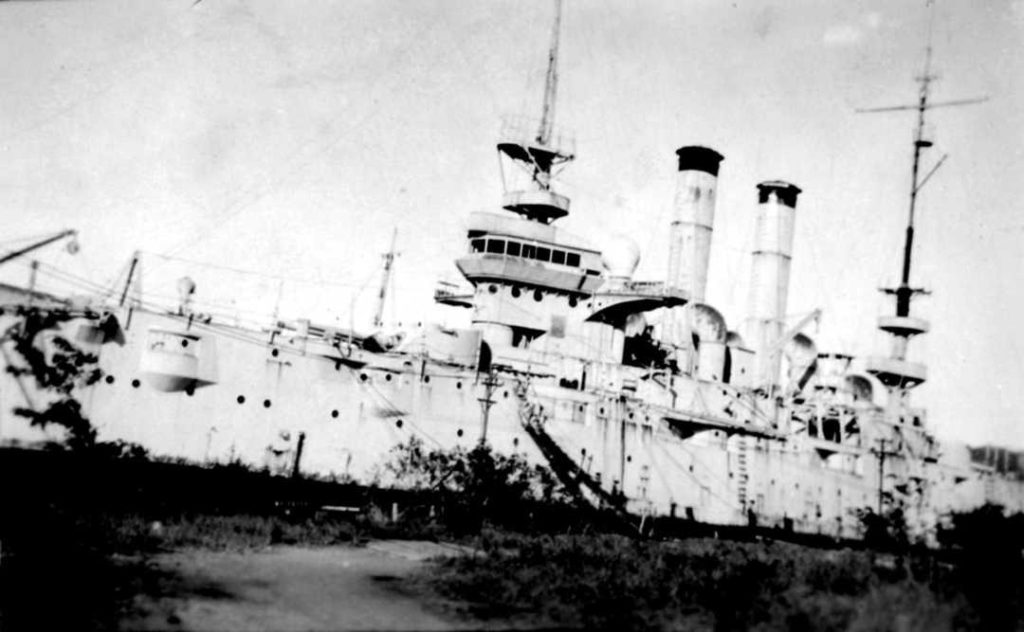
USS Rochester mothballed at Olongapo, 1938. (navsource.org)
Gallery
Sources, read more
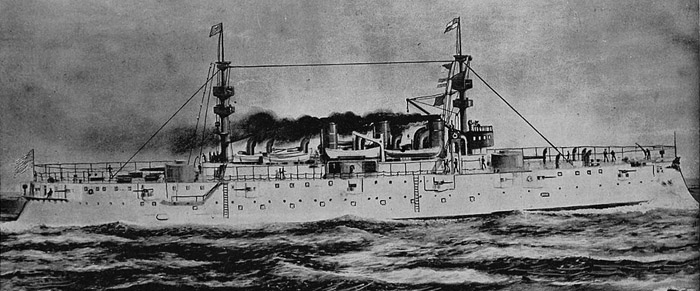
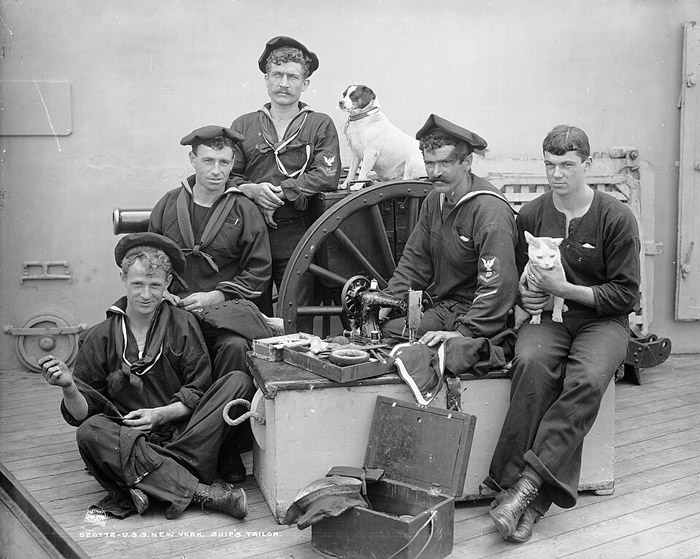
Books
Conway’s all the world fighting ships 1860-1905, 1906-1921.
Alden, John D. American Steel Navy: A Photographic History of the U.S. Navy from the Introduction of the Steel Hull in 1883 to the Cruise of the Great White Fleet.
Bauer, K. Jack; Roberts, Stephen S. (1991). Register of Ships of the U.S. Navy, 1775–1990: Major Combatants. Greenwood Press.
Bennett, Tom (2010). Shipwrecks of the Philippines (E-book). Wales, UK: Happy Fish Publications.
Burr, Lawrence. US Cruisers 1883–1904: The Birth of the Steel Navy. Oxford : Osprey, 2008.
Davis, Charles W. “Subic Bay: Travel & Diving Guide.” Manila, Philippines, Encyclea Publications, 2007.
Friedman, Norman (1984). U.S. Cruisers: An Illustrated Design History. NIP
Jane’s Fighting Ships 1905/6. Arco Publishing Company, Inc. (reprint) 1970.
Munsey’s Magazine Volume XXVI. October 1901, to March 1902. Page 880
Musicant, Ivan. U.S. Armored Cruisers: A Design and Operational History. NIP
Taylor, Michael J.H. (1990). Jane’s Fighting Ships of World War I. Studio.
Thomas, Stephen L. (2004). “Question 36/03: Wrecks of Pre-WW I Warships”. Warship International. XLI (4): 338–339.
Links
on history.navy.mil/
navypedia.org/ us_cr_rochester.htm
navweaps.com/ 8-in 35_mk3.php
http://newspapers.com/ uss_new_york_acr2
en.wikipedia.org/ New_York_(ACR-2)
spanamwar.com
web.archive.org/ navsource.org/ acr2.htm
navsource.org archives, blueprint and photos
on commons.wikimedia.org USS_New_York
irootoko JR USN colorized photos
https://www.spanamwar.com/newyork.htm
https://www.militaryfactory.com/ships/detail.php?ship_id=USS-New-York-acr2
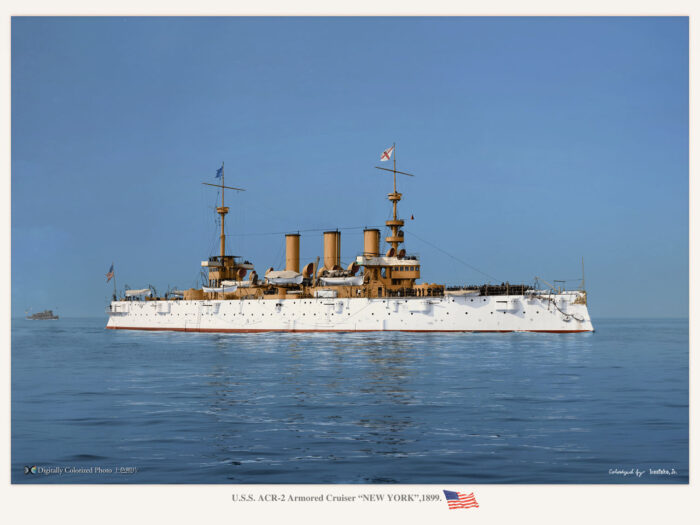
Video
Model Kits
on scalemates.com/
on modelshipgallery.com


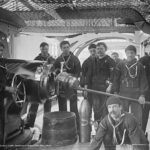
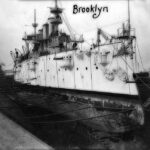

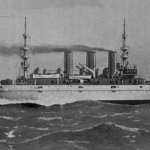
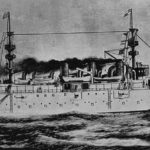

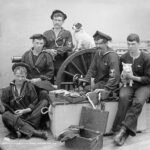


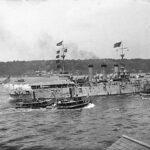
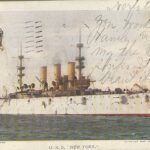
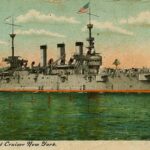
 Latest Facebook Entry -
Latest Facebook Entry -  X(Tweeter) Naval Encyclopedia's deck archive
X(Tweeter) Naval Encyclopedia's deck archive Instagram (@navalencyc)
Instagram (@navalencyc)





 French Navy
French Navy Royal Navy
Royal Navy Russian Navy
Russian Navy Armada Espanola
Armada Espanola Austrian Navy
Austrian Navy K.u.K. Kriegsmarine
K.u.K. Kriegsmarine Dansk Marine
Dansk Marine Nautiko Hellenon
Nautiko Hellenon Koninklije Marine 1870
Koninklije Marine 1870 Marinha do Brasil
Marinha do Brasil Osmanlı Donanması
Osmanlı Donanması Marina Do Peru
Marina Do Peru Marinha do Portugal
Marinha do Portugal Regia Marina 1870
Regia Marina 1870 Nihhon Kaigun 1870
Nihhon Kaigun 1870 Preußische Marine 1870
Preußische Marine 1870 Russkiy Flot 1870
Russkiy Flot 1870 Svenska marinen
Svenska marinen Søværnet
Søværnet Union Navy
Union Navy Confederate Navy
Confederate Navy Armada de Argentina
Armada de Argentina Imperial Chinese Navy
Imperial Chinese Navy Marinha do Portugal
Marinha do Portugal Mexico
Mexico Kaiserliche Marine
Kaiserliche Marine 1898 US Navy
1898 US Navy Sovietskiy Flot
Sovietskiy Flot Royal Canadian Navy
Royal Canadian Navy Royal Australian Navy
Royal Australian Navy RNZN Fleet
RNZN Fleet Chinese Navy 1937
Chinese Navy 1937 Kriegsmarine
Kriegsmarine Chilean Navy
Chilean Navy Danish Navy
Danish Navy Finnish Navy
Finnish Navy Hellenic Navy
Hellenic Navy Polish Navy
Polish Navy Romanian Navy
Romanian Navy Turkish Navy
Turkish Navy Royal Yugoslav Navy
Royal Yugoslav Navy Royal Thai Navy
Royal Thai Navy Minor Navies
Minor Navies Albania
Albania Austria
Austria Belgium
Belgium Columbia
Columbia Costa Rica
Costa Rica Cuba
Cuba Czechoslovakia
Czechoslovakia Dominican Republic
Dominican Republic Haiti
Haiti Hungary
Hungary Honduras
Honduras Estonia
Estonia Iceland
Iceland Eire
Eire Equador
Equador Iran
Iran Iraq
Iraq Latvia
Latvia Liberia
Liberia Lithuania
Lithuania Mandchukuo
Mandchukuo Morocco
Morocco Nicaragua
Nicaragua Persia
Persia San Salvador
San Salvador Sarawak
Sarawak Uruguay
Uruguay Venezuela
Venezuela Zanzibar
Zanzibar Warsaw Pact Navies
Warsaw Pact Navies Bulgaria
Bulgaria Hungary
Hungary

 Bundesmarine
Bundesmarine Dutch Navy
Dutch Navy Hellenic Navy
Hellenic Navy Marina Militare
Marina Militare Yugoslav Navy
Yugoslav Navy Chinese Navy
Chinese Navy Indian Navy
Indian Navy Indonesian Navy
Indonesian Navy JMSDF
JMSDF North Korean Navy
North Korean Navy Pakistani Navy
Pakistani Navy Philippines Navy
Philippines Navy ROKN
ROKN Rep. of Singapore Navy
Rep. of Singapore Navy Taiwanese Navy
Taiwanese Navy IDF Navy
IDF Navy Saudi Navy
Saudi Navy Royal New Zealand Navy
Royal New Zealand Navy Egyptian Navy
Egyptian Navy South African Navy
South African Navy






























 Ukrainian Navy
Ukrainian Navy dbodesign
dbodesign